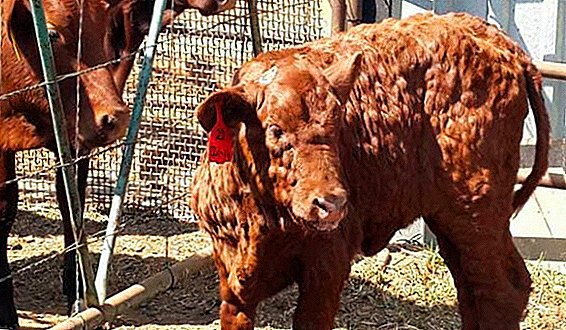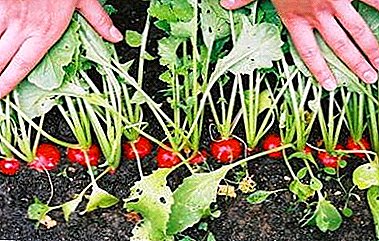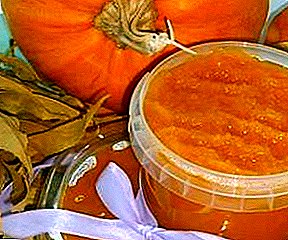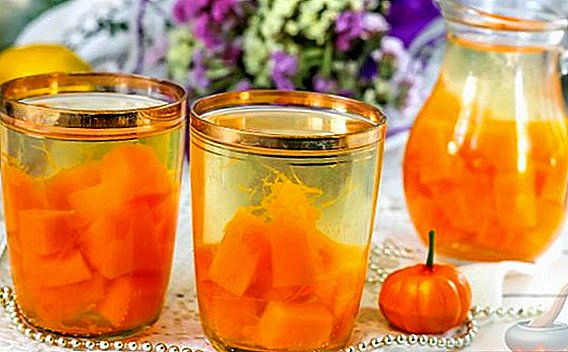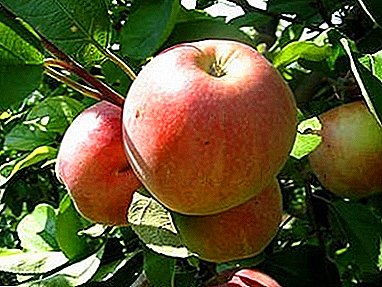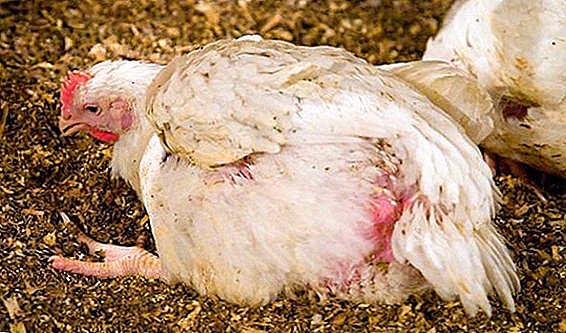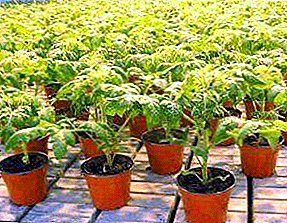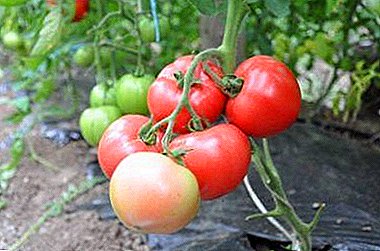
Relatively recently, a new variety of tomatoes was bred in Japan, which managed to gain popularity among our compatriots.
Pink Paradise Hybrid has a high yield, unpretentiousness and good immunity.
But this variety also has its own peculiarities of content that you should know about in order to achieve tasty and healthy fruits. In this article we will talk about the characteristics of the Pink Paradise variety and how to properly care after planting in the greenhouse.
Characteristics of a variety
| Type of variety | Hybrid |
| Bush height | Up to 2 m |
| Leaves | Small and medium |
| Fruit Form | Round |
| Colour | Pink |
| Fruit weight | 120g to 200g |
| Fruit taste | Sweet |
| Ripening | From 115 to 120 days |
| Harvest amount | Up to 4 kg of fruit per 1 m2 |
Growth in a greenhouse: special requirements and conditions
 Pink Paradise tomato is not particularly picky about its content. As with the care of other tomatoes, you need to water the plants on time and moderately, use the necessary fertilizers and get rid of pests. However, there are things that are worth focusing on.
Pink Paradise tomato is not particularly picky about its content. As with the care of other tomatoes, you need to water the plants on time and moderately, use the necessary fertilizers and get rid of pests. However, there are things that are worth focusing on.
- First of all, it is important to air the greenhouse after abundant watering and on hot days.
- In addition, you need to remove the extra stepchildren who grow in excess of this variety.
- It is necessary to remember about the support of the stems: they are tied to strong stakes, because the bushes will be high.
- As for the soil, it must be nutritious and not over-saturated. It is best to prepare it yourself. For this, garden soil is mixed with river sand and humus is added.
So that the acidity in the soil does not exceed the norm, add a little wood ash to the mixture.
Seed preparation
Growing seedlings begins in mid-late February. Preliminary preparation for seeds of this type of tomato is not required. If desired, further accelerate the development of plants, you can soak the seeds in a solution of growth stimulant for about 10 hours.
Seedling
- In the seed box pour out the ground and make small holes with a depth of one and a half to two centimeters.
- One grain is planted in each well, lightly watered and sprinkled with peat.
- After that, the box is covered with foil and put in a warm dark place for 5 days (the temperature must be at least 23 degrees).
- After 5 days, the shoots should appear first leaves. At this time, the seedlings are carried out to the bright daylight, and two real leaves are awaited.
- Seedlings moistened by spraying it with a spray bottle. When the first real leaves grow, the plants dive - they sit in different pots.
- When 2 months have passed since planting, the tomatoes should be transferred to a greenhouse.
What should be the facility for tomatoes?
The size
The most suitable height of the greenhouse on the ridge is about two and a half meters, since the bushes reach 2 m, and for normal maintenance it is necessary that there is at least another 50 cm of space above the top of the plant. The width of the greenhouse should be at least three meters, and the long part depends on the number of seedlings.
Materials
 The foundation is something to think about in the first place, since in most parts of the country rainy summer is not uncommon. Finely recessed strip foundation is quite suitable for a tomato greenhouse.
The foundation is something to think about in the first place, since in most parts of the country rainy summer is not uncommon. Finely recessed strip foundation is quite suitable for a tomato greenhouse.
For the greenhouse frame, the two most optimal options are wood and aluminum.
- Tree It is considered safer since it does not overheat and the leaves of the plants are not burned on the frame. The disadvantage of wood is that it is short-lived: it can rot 2 years after use. To avoid this, you must either cover the crossbar with special paint, or use poles with stripped bark.
- Aluminum more durable, but there are problems with overheating. You can cover the greenhouse and film, but it will have to be changed every year or two. It is better to use glass or polycarbonate. Glass, you can take the window, or buy special greenhouses. The main thing that the glass thickness was not less than 4 mm.
- Polycarbonate It is most suitable because it provides good climate control: it protects from frost in winter, and protects plants from excessive UV in summer. At the same time, it does not break and can be rolled into rolls.
Preparing for landing
Even in the fall you want to prepare a greenhouse for planting tomatoes. If the greenhouse is not new and other crops were grown in the season, you need to check the soil and get rid of plant residues. At the same time, the land on which they grew peppers and potatoes cannot be used - tomatoes on it will grow poorly.
Tomatoes feel best in the soil where they used to grow pumpkins, cucumbers or zucchini. To the soil cleared of pests and enriched with nutrients, it is good to plant mustard in the fall. By winter, plants can be cut.
Important: if the crops that lived in the soil of the previous season were sick, the soil should be completely changed. A layer of 30 centimeters is removed, and all surfaces of the greenhouse are treated with fungicide.
The most nutritious soil composition for greenhouse tomatoes is a mixture:
- river sand;
- peat;
- garden land;
- rotted manure (better to use horse);
- compost.
In the spring they are disinfecting the greenhouse: all surfaces should be treated with a Baikal-EM solution. And the beds are heated, pouring boiling water over them. 14 days before planting, the soil is fertilized:
- superphosphate (30 grams);
- potassium sulfate (15 grams);
- ammonium nitrate (20 grams).
Transferring plants to the greenhouse
 For tall varieties, such as Pink Paradise, usually use a chess fit. This scheme shows the landing on 32 bush, but it can be adjusted depending on the desired number of plants.
For tall varieties, such as Pink Paradise, usually use a chess fit. This scheme shows the landing on 32 bush, but it can be adjusted depending on the desired number of plants.
Landing Instructions:
- The landing starts in May. At this point, the beds should be ready. The height of the beds should not exceed 40 cm, and the approximate width - 60-65 cm. The passage should be no more than half a meter wide.
- In the beds make holes. In this case, the distance between the rows should be from 80 cm to one meter, and the distance from one hole to the other should be 70 cm.
- Immediately before planting, the soil should be treated with a solution of potassium permanganate and copper sulfate.
- The plants themselves, before planting in the greenhouse, watered with phytosporin.
- When tomatoes are planted in the hole, each bush must be tied to a long peg, strong enough to withstand the plant.
- After that, every bush you need to pour water.
Care
Pink Paradise tomatoes are disease resistant, however, they are not protected from pests. If slugs appear, the bushes should be treated with ammonia solution. There are a few more features of care.
Watering
This sort of tomato is more afraid of excessive watering than drought. After the tomatoes have been watered when they are planted, they will not need to be moistened for another 30 days: there will be enough nourishment from the soil thanks to strong roots. At the same time you need to keep track of the holes: if the ground is dry in them, you can water the plant a little under the root.
Top dressing
- After planting it is useful to feed the tomatoes with nitrogen fertilizer, and a second time to use it during the ovary of the fruit.
- When the fruits ripen, apply potassium phosphate fertilizer. Potassium ensures the growth of fruits, and phosphorus improves the vegetation of vegetable crops.
- To stimulate fruiting during one of the irrigations, you can fertilize plants with succinic acid or with the “Mortar” preparation. When using the latter, you must clearly follow the instructions on the packaging.
Masking and forming a bush
In tomato bushes, stepchildren form in two stalks. As soon as the branch point of the new stalk has been outlined, the stepson must be cut off. It is necessary to check the tomatoes 1-2 times a week and remove all stepchildren so that only one trunk of the bush remains. If the seedlings are small and you need more fruits, you can leave one, the very first stepson - he is usually the most powerful.
Fruit picking
After 70 days after the seedlings were planted, you can harvest. Fruiting will last until about the second decade of September, and all this time you can regularly collect tomatoes. From one bush, you can wait for 3 or even 4 kg of fruit.
The ripened fruit has a bright pink color. If you can see beetles or slugs when harvesting fruits, they are removed manually, after which the fruits are disinfected with liquid ammonia.
Insect repellent chemicals must not be used during collection. Tomatoes "Pink Paradise" - one of the best greenhouse varieties. If you comply with the conditions of care, abundant harvest provided. The fruits of this variety are not only cute in appearance, but also beautiful in taste, while winning over the concentration of healthy substances from red tomatoes.




